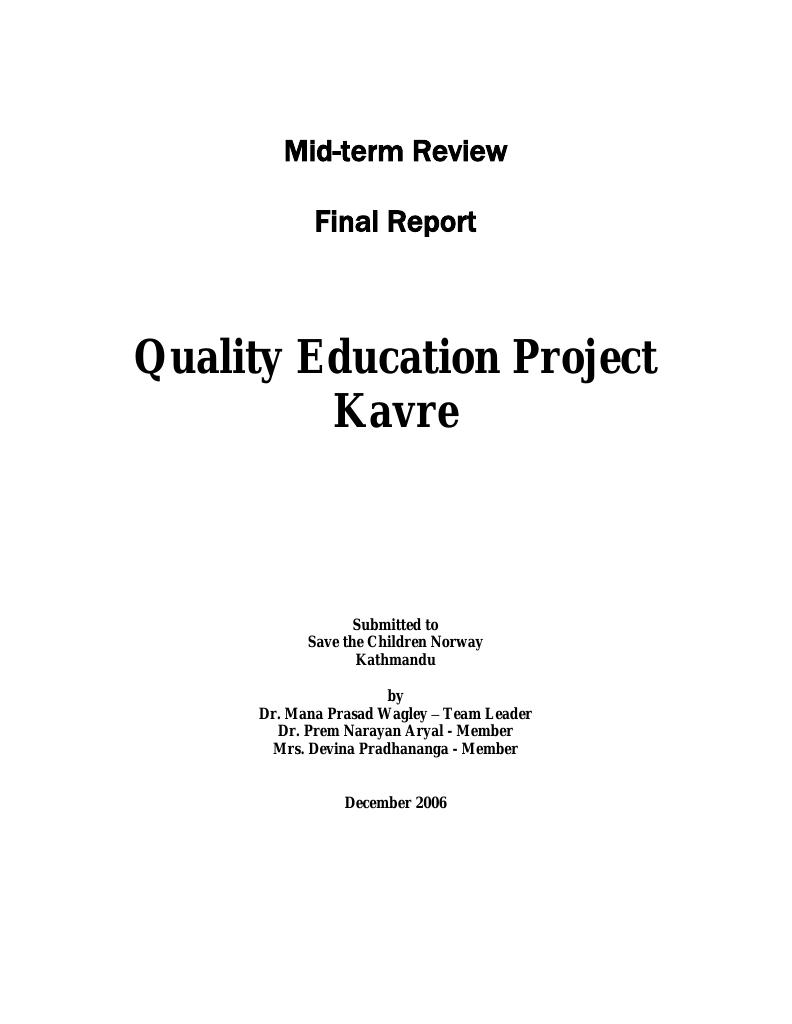Evaluering
Mid term evaluation of Kavre quality education project
Background: Currently, Save the Children Norway-Nepal (SCNN) works in more than 23 districts in partnership with Government agencies and NGOs in education theme. SCNN has been implementing quality primary education program in Kavre district under a tripartite Memorandum of Understanding (MOU) with Setogurans National Child Development Services (SGNCDS) and Department of Education (DOE) since 2003. SCNN has been providing technical and financial support to District Education Office Kavre and SGNCDS to implement the programs as per the frame indicated in the MOU. The existing agreement comes to end in November 2006. Kavre education project is the first pilot project of SCNN with Government agency as implementing partner, the approach of improving quality primary education through this model has potential for wider replication in other SCNN districts. Purpose / objective as specified in the terms of reference:1. To provide an analysis of the contributions/impact of the programme made by Seto Gurans/DOE and SCNN as perthe objectives set in the MOU and the challenges interfaced in improving quality of education in selected VDCs of Kavre. The review will specifically look into:• Impact on children’s lives, participation and learning• Impact on community and their ownership• Impact on program planning, implementation and monitoring process at district level2. To identify emerging issues and lessons learnt and best practices over the past few years of partnership. To analyze strengths of the program and areas for improvements3. To explore objectives, strategies and areas of cooperation and relevance of support for the next phase partnership and forthcoming country strategy period. Methodology: • Document review• Discussion with DEO staff, SMC/PTA members, teachers, parents and related stakeholders including SCNN andSeto Gurans staff• Interview (Teachers, SMC members, DEO officials and community members)• Discussion with key stakeholders• Observations Key findings:• Awareness raising and sensitization in education is increased through ECD and quality education programme inKavre• Access of children in education is increased and very negligible percentage of children aged 5-9 children are out ofschool.• Teachers are prepared to deliver quality education and class rooms are also developed child friendly manner. As aresult teaching learning environment is improved well.• Capacity building of stakeholders, an increase in involvement of community and parents in school activities reflectstheir increased ownership of the school• SCNN’s support increased the infrastructure of ECD centers and schools (including toilets, drinking water etc.) which enabled children to get opportunity to learn in child friendly physical environment• The partnership with SCNN has strengthened the capacity of DEO staff, teachers, SMC/PTA and ECD managementcommittee. This capacity leaded towards the institutional development of the different local and district level structures.• Parenting education to care givers, monitoring capacity to DEO staff and community, fostering of ECD, provision ofKey Teachers and support to ECD network, supported to make all stakeholders accountable towards children and their appropriate development.• Positive impact on children's life through providing opportunity to participate and to learn.• Community's concern to mobilize resources is increased Recommendations:• Necessary for SCNN to discuss with the beneficiaries both at the central level (MOES and DOE) and at the local level (DEO) to convince and commit to spend the minimal amount to maintain the quality of program that they started jointly with SCNN.• Make sure that the local government is fully involved in project planning, implementation and monitoring. There should be a mechanism to get their approval before the project starts. Moreover, MOU with VDCs is equally important. If the program is to be spread in more VDCs in the future then MOU with DDC will also be required for the sustainability of programme.• Make sure that there are enough funds for transition. Beneficiaries should be assured that they are not left out by the donors immediately after the project period is over. The important thing to note is that SCNN should plan its transition of phasing out from the first year. SCNN and the government should have enough funds so that the funds could be utilized to maintain the program for certain years after the project is over.• Increasing the ownership of program from the district level government bodies is important. SCNN should seek theownership of local bodies to plan and implement the program by them. SCNN should be more careful in future that the program is led by local bodies, by making plans of their own and asking SCNN for additional support only.• Make government staff and structure to be responsible to monitor program regularly.
